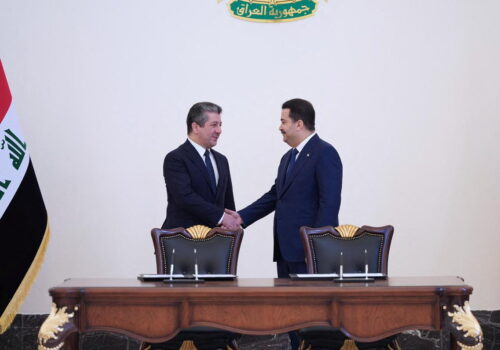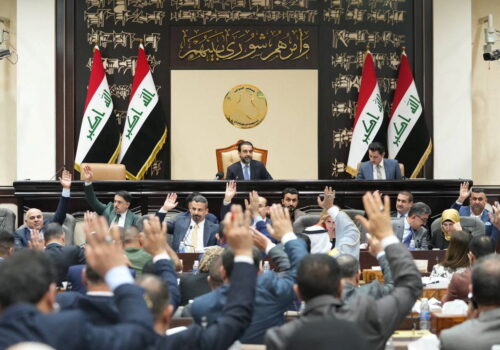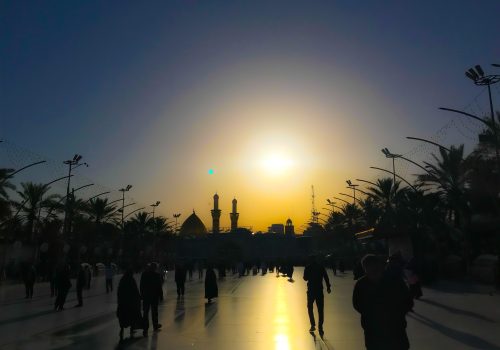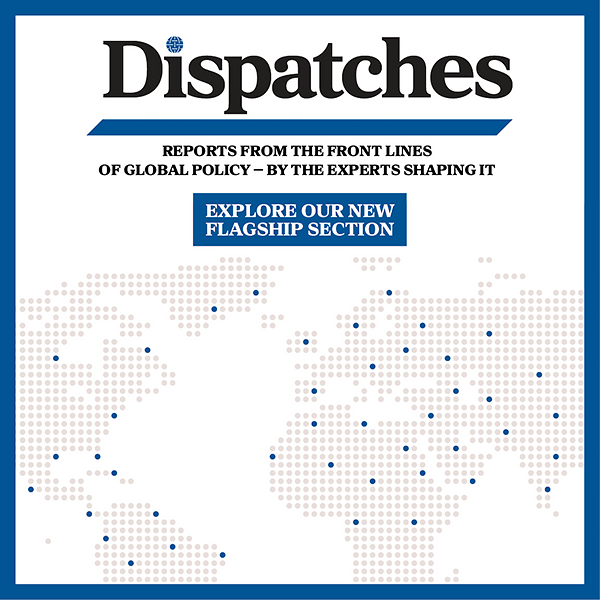Regenerative farming in Iraq: Challenges, opportunities, and policy recommendations
Bottom lines up front
- Iraq’s arable land shrinks every year, sending rural residents to already-crowded cities, and traditional farming practices increase the speed and severity of the crisis.
- Regenerative farming practices could save the Iraqi government money currently spent on pesticide and chemical subsidies and reduce migration of rural communities.
- Iraq needs also needs policy reforms that tie government support to sustainable agriculture, and funding, expertise, and tech from the international community to support farmers transitioning to regenerative methods.
Executive summary
As temperatures soar above 50 degrees Celsius (122 degrees Fahrenheit) in Iraq and desertification claims 400,000 acres annually, traditional farming systems are contributing to the severe climate impacts. Iraq stands at a critical environmental crossroads, where climate change, land degradation, and water scarcity threaten not just its agricultural heritage but its national security. However, there is an emerging farming method with historical roots—called regenerative farming—that is being innovatively adapted to modern conditions and can be seen as viable solution for Iraq.
Regenerative farming is gaining global recognition as a transformative agricultural strategy that does more than just mitigate climate change impacts—it actively reverses environmental degradation while delivering substantial economic benefits. Research shows this approach can increase farm productivity by more than 70 percent while reducing energy costs by 45 percent. For the Iraqi government, which currently subsidizes 50 percent of pesticide and chemical input costs, this method offers significant fiscal relief. The shift would be particularly beneficial for smallholder farmers who depend on government agricultural programs for survival, providing a path to self-sufficiency while reducing state expenditure on chemical subsidies within two years.
Iraqi farmers face an existential crisis as their arable land diminishes yearly, caught between severe climate change impacts and the government’s lack of environmentally sustainable agricultural policies. The decline in traditional agriculture has triggered a mass exodus from rural areas to cities, fundamentally reshaping Iraq’s socioeconomic landscape. This rural-urban migration has overwhelmed urban infrastructure and services while creating widespread employment instability. However, within this crisis lies an opportunity: Adopting modern, sustainable farming methods could both rejuvenate rural communities and ease urban pressures, offering a path toward agricultural renewal and social stability.
This policy brief explores how regenerative farming offers a viable solution to Iraq’s agricultural challenges by restoring the environment, enhancing productivity, and improving public health. This approach is a reimagining of agriculture in Iraq and offers more than a set of farming practices: It presents a paradigm shift for the state and the farmers.
Drawing from successful international case studies and local expertise, this brief presents actionable recommendations for scaling these practices nationwide. this policy brief shows that Iraq’s environmental challenges can be addressed through strategic interventions that rebuild soil health, increase biodiversity, and mitigate climate impacts.
Implementation requires a three-pronged approach:
- Targeted agricultural practices that prioritize ecological restoration and sustainable production.
- Policy reforms that incentivize sustainable farming and support farmers transitioning to regenerative methods.
- International cooperation to leverage global expertise, technology, and funding for widespread adoption.
Key findings and recommendations
My research reveals several critical findings regarding environmental restoration efforts in Iraq including:
- The lack of systematic data collection and monitoring mechanisms hinders accurate assessment of the impact of Global Environment Facility (GEF) projects in southern Iraq and the potential for replication elsewhere.
- Current coordination between national and local authorities remains fragmented, leading to implementation delays and reduced efficiency.
- Existing environmental projects often operate in isolation without integration into broader national agricultural and water management strategies.
- Farmers currently spend $200 on pesticide per hectare, half of which is often covered by state subsidy programs.
- Government subsidy policies create a disincentive for sustainable farming practices by failing to differentiate between chemical and organic inputs. The subsidy rate for each one is the same despite the higher base cost of organic fertilizers. Higher out-of-pocket costs effectively discourage farmers from adopting organic methods, despite their long-term environmental and health benefits.
Practical recommendations
- Short-term actions (one to two years):
- Establish a centralized digital database within the Ministry of Environment to track project outcomes, soil-quality improvements, and water-usage patterns.
- Create a joint task force between the Environment, Water Resources, and Agriculture ministries to streamline project approvals and resource allocations.
- Develop practical training modules for farmers, focusing on water-efficient irrigation techniques and soil-restoration methods.
- Launch pilot programs offering financial incentives to farmers who adopt sustainable farming practices.
- Medium-term actions (two to five years):
- Expand successful pilot projects to new regions, prioritizing areas most affected by desertification.
- Create policy reform and a certification program for regenerative farming practices, linking implementation of these practices to preferential access to government agricultural support.
- Establish regional knowledge-sharing centers where successful farmers can mentor others in sustainable techniques.
- Long-term strategic initiatives (five-plus years):
- Integrate environmental restoration projects into Iraq’s national food-security strategy.
- Create a sustainable agriculture fund supported by both government allocations and international donors.
- Develop climate-resilient farming zones with specialized support and infrastructure.
- Establish research partnerships between Iraqi universities and international institutions to improve farming techniques suitable for Iraq’s climate.
Introduction
A. Objectives of the policy brief
This policy brief aims to provide a comprehensive overview of the current state of farming practices and agricultural policies in Iraq, focusing on the potential of regenerative farming as a solution to the pressing challenges faced by the country’s agricultural sector and its role in mitigating climate change impacts.
The specific objectives of this policy brief are:
- Current farming practices: Examine the prevailing farming methods in Iraq, including the reliance on industrial agriculture, monocultures, and chemical inputs and their impact on soil health, water resources, and overall agricultural sustainability.
- Agricultural policies: Analyze the existing agricultural policies in Iraq and their effectiveness in supporting farmers, promoting sustainable practices, and addressing the challenges posed by climate change and desertification.
- Regenerative farming successes: Highlight successful examples of regenerative farming practices in Iraq, showcasing their potential to restore degraded lands, improve soil fertility, increase biodiversity, and enhance food security.
- Challenges and barriers: Identify the main challenges and barriers to the adoption and scaling up of regenerative farming in Iraq, including knowledge gaps, financial constraints, institutional capacity, and policy hurdles.
- Policy recommendations: Provide clear and actionable recommendations to support the transition toward regenerative agriculture in Iraq.
B. Background on regenerative farming and its global significance
Regenerative farming represents a transformative approach to agriculture that has demonstrated remarkable success in combating environmental degradation worldwide. In Ethiopia’s Tigray region, these practices restored one million hectares of degraded land into productive farmland by 2012, dramatically improving food security. China’s Loess Plateau project, implementing similar principles, transformed 35,000 square kilometers of drought-prone land into thriving agricultural areas, lifting 2.5 million people out of poverty. Such practices, including cover cropping, rotational grazing, and minimal tillage, work by rebuilding soil health, enhancing biodiversity, and improving water retention. These successes offer promising solutions for Iraq’s environmental challenges. The principles that revitalized degraded lands in arid regions like Australia’s outback—where regenerative farming increased soil carbon by 40 percent and water retention by 30 percent—demonstrate the potential for transforming Iraq’s threatened agricultural lands into resilient, productive ecosystems.
II. State of regenerative farming and its feasibility in the Iraqi context
A. The importance of regenerative farming in Iraq
Iraq, historically celebrated as the “cradle of civilization,” faces an unprecedented environmental crisis that threatens its agricultural foundation and national stability. The convergence of accelerated climate change—with temperatures regularly exceeding 50°C—and severe water scarcity has devastated the country’s farming sector. According to the United Nations Development Programme (UNDP), Iraq loses approximately400,000 acres of arable land annually to degradation, while its Ministry of Agriculture reports that 70 percent of agricultural land risks desertification. The flow of both the Tigris and Euphrates rivers has diminished by 60 percent in recent decades, exacerbating soil salinity and water scarcity. This environmental degradation, coupled with decades of conflict and neglect, has transformed Iraq from an agricultural powerhouse—where farming contributed 20 percent of gross domestic product before 2003—to a nation dependent on food imports, with agriculture accounting for merely 3.3 percent of GDP in 2019. The resulting rural-to-urban migration and increasing food insecurity underscore the urgent need for sustainable solutions, positioning regenerative agriculture as not merely an environmental initiative but a crucial strategy for national security and economic stability.
For Iraq, the potential benefits of regenerative farming are profound and multifaceted:
- Climate resilience: Farms using regenerative practices were 78 percent more resilient to drought conditions compared to conventional farms.
- Profitability: Farms with regenerative practices were 78 percent more profitable than conventional plots. Farmers that implement regenerative principles match or surpass conventional yields, especially in drought years.
- Water conservation: Regenerative and organic systems use 45 percent less energy and 40 percent less water than conventional systems.
B. Regenerative farming initiatives and projects—and their challenges
While acknowledging the limited knowledge and support for regenerative farming practices in Iraq and the paucity of individually funded projects, it is useful to look at a few notable pilot projects that international organizations have implemented in Iraq, which were inspired by the benefits of regenerative farming elsewhere.
Enduring Harvest, a project located in southern Iraq, focuses on introducing regenerative agriculture practices to local farmers and communities. The project is self-funded by a group of Iraqi Americans and located in the Badiya Desert in Samawa province. The initiative employs a range of regenerative farming techniques, including composting, cover cropping, crop rotation, and agroforestry, to improve soil health, increase crop yields, and enhance the resilience of local food systems.
The project faces multiple interconnected challenges. Knowledge gaps exist between farmer and policymaker levels, necessitating extensive education and training programs. The labor-intensive nature of regenerative farming poses a significant economic hurdle, particularly for farmers dependent on daily wages. While the project hasn’t yet achieved profitability, it continues to make progress toward its goals, according to the co-founder and director of the project.
The Global Environment Facility (GEF), a US-based organization that calls itself the family of funds for the environment, has been at the forefront of addressing environmental challenges in Iraq since 2010. GEF’s work focuses on reversing climate change impacts, addressing biodiversity loss, and combating land degradation. GEF’s current projects in southern Iraq, implemented under the supervision of the Ministry of Environment and funded by UNDP, demonstrate a comprehensive approach to environmental restoration.
While not explicitly labeled as regenerative farming, GEF’s projects incorporate fundamental regenerative principles in their land restoration efforts. These initiatives encompass soil restoration, water-management optimization, and capacity building among farmers and local officials. The programs also address broader challenges, including biodiversity conservation, farmer migration to urban areas, and Iraq’s food security concerns.
Several small-scale projects incorporating regenerative farming principles have been implemented in Nineveh province by international organizations, though they remain relatively unknown. However, these initiatives operate largely outside the purview of both the federal Ministry of Agriculture in Baghdad and the Ministry of Environment, and there is limited public data available to assess their long-term impact and success rates. This lack of coordination between international organizations and government ministries represents a missed opportunity for knowledge sharing and potential scaling of successful approaches. The absence of systematic documentation and evaluation of these projects also makes it difficult to replicate successful models or learn from their experiences in other parts of Iraq.
III. Policy landscape
A. Analysis of current agricultural policies in Iraq
Iraq’s agricultural policies, led by the Ministry of Agriculture under Prime Minister Mohammed Shiaa al-Sudani’s administration, reflect a conventional approach that prioritizes immediate production and job creation over sustainability. While the government’s four-year vision demonstrates commitment to agricultural development, it primarily focuses on traditional support mechanisms: seed distribution, essential crop subsidies, and protective tariffs for domestic production.
Current policy instruments include:
- Purchase guarantees for strategic crops (wheat and barley).
- Equipment subsidies and infrastructure support.
- Seasonal import restrictions to protect local farmers.
- Basic irrigation-system maintenance.
Notably, al-Sudani’s administration has introduced a separate climate change initiative through the Ministry of Environment and special envoy for climate change, but these environmental policies remain disconnected from agricultural programs.
Key policy gaps:
- Minimal research funding for sustainable farming practices.
- No integration of environmental policies with agricultural subsidies.
- Limited coordination between climate and farming programs.
- No systematic framework for promoting regenerative agriculture.
- A lack of data on agricultural projects’ contribution to climate impacts in Iraq.
This fragmented approach, while addressing both agricultural and climate needs separately, fails to create synergies necessary for long-term environmental sustainability.
B. Policy challenges and structural limitations in Iraqi agriculture
Iraq’s agricultural policy framework faces significant structural challenges that hinder the adoption of sustainable farming practices. The current system primarily emphasizes conventional farming through immediate support mechanisms—including wheat and barley purchase guarantees, equipment subsidies, and seasonal tariffs—while neglecting long-term sustainability concerns.
Key institutional and policy gaps:
- Competing ministerial priorities create policy conflicts: The Agriculture Ministry’s farmer support programs often clash with the Water Resources Ministry’s conservation initiatives and the Environment Ministry’s climate action plans.
- Limited coordination between federal and regional authorities fragments policy implementation.
- Research funding and technical support for sustainable farming practices are insufficient.
- Financial incentives remain focused on conventional rather than regenerative methods.
The political sensitivity of agricultural reform further complicates policy changes, as farmers, particularly in southern Iraq, represent a significant voting bloc. This political dynamic often leads to maintaining status quo policies despite their environmental drawbacks. Current support systems, while providing necessary immediate assistance to farmers, inadvertently discourage the adoption of sustainable practices like drip irrigation and regulated chemical usage due to perceived additional costs and lack of financial support for sustainable farming.
These challenges are exacerbated by inadequate institutional frameworks for promoting regenerative agriculture. A fragmented approach between various ministries and agencies creates implementation gaps and reduces policy effectiveness. Addressing these limitations requires a coordinated strategy that balances immediate farmer needs with long-term environmental sustainability goals.
C. Opportunities for policy intervention and support
Despite the challenges and limitations in the current agricultural policies in Iraq, there are significant opportunities for policy intervention to promote regenerative agriculture there. The following steps are necessary and required to address policy issues.
- Aligning regenerative agriculture with government priorities: Policymakers in Iraq, particularly in southern Iraq and Nineveh, are keen on supporting local farmers and rural communities, as they rely on their support during elections.
- Addressing climate change and environmental challenges: The Iraqi government is increasingly aware of the severe impacts of climate change on agriculture, such as water shortages and desertification. Regenerative agriculture is a viable solution to mitigate these challenges, as it focuses on building soil health, improving water retention, and enhancing the resilience of agroecosystems.
- Engaging agricultural engineers and experts: Iraq has a significant number of agricultural engineers and graduates from agricultural colleges, many of whom currently need to be working in the sector.
- Building on local preferences for domestic products: Iraqi consumers generally favor locally produced agricultural products, even though they may be more expensive or less readily available than imported goods.
IV. Conclusion: Call to action for policymakers and stakeholders
Iraq stands at a pivotal moment in its agricultural history. The land that gave birth to farming 12,000 years ago now faces an existential crisis that threatens not only its agricultural heritage but it’s very survival as a nation. The convergence of climate change, water scarcity, and land degradation presents not just a challenge but an urgent mandate for transformation. This is not merely about preserving agriculture—it’s about reimagining it.
Regenerative agriculture offers more than a set of farming practices: It presents a paradigm shift in how we think about food production, environmental stewardship, and national resilience.
Bold, transformative policies are needed that:
- Redirect a portion of agricultural subsidies from conventional to regenerative practices.
- Create dedicated funding streams for regenerative farming research and implementation.
- Establish a national regenerative agriculture training program.
- Develop market incentives for sustainable farming practices.
- Reform water policies to prioritize efficient, sustainable usage.
IV. Appendix: List of interviewees and experts consulted for this policy brief
Minister Nazar Amedi, Minister of Environment
Dr. Najla Muhsen al-Waeli, General Director, Ministry of Environment
Dr. Sajad Zalzal, Co-Founder and Director, Enduring Harvest Project
Kadhim al-Huassani, Economic Adviser to the Prime Minister of the Republic of Iraq
Begard Talabani, Minister of Agriculture and Water Resources for the Kurdistan Region
Hassan al-Kaabi, Former Deputy Speaker of the Iraqi Council of Representatives
Related content
Explore the program

The Iraq Initiative is driving policy-oriented programs and analysis that advance Iraq’s stability and sovereignty, regional integration, and democratic and economic development. It also aims to promote a strengthened US-Iraq partnership.
Image: United Nations Development Programme, 2024



